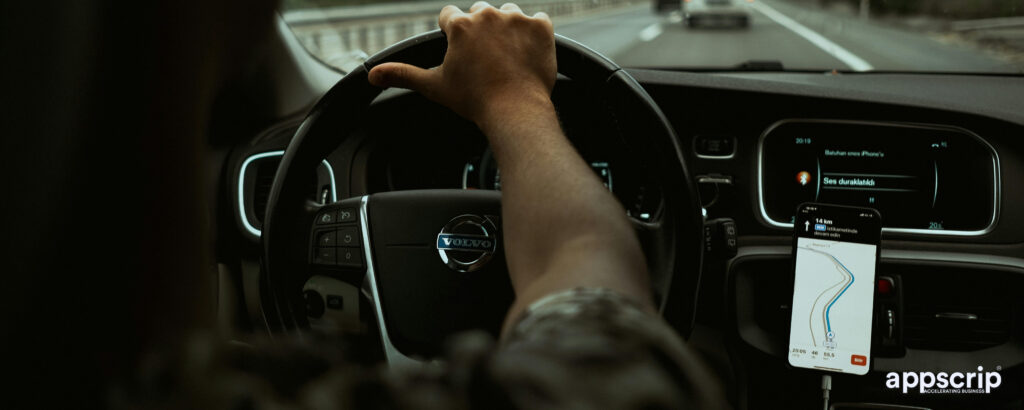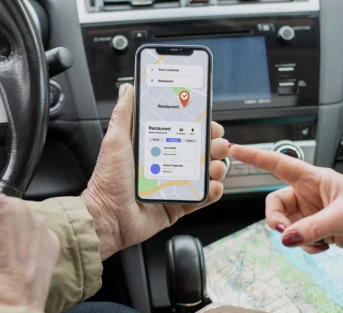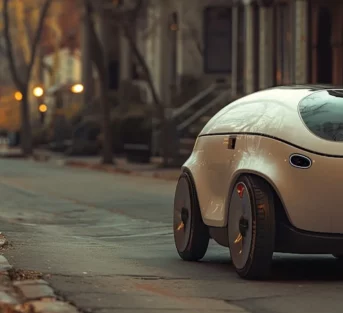Thinking about launching your own ride-hailing service? Join the queue. The ride-hailing industry has exploded, and everyone wants a piece of this pie. So let’s then talk about Uber app development cost—because it’s more about “what will it cost” and less about “how to go about it”.
But here’s the thing: creating an app that’s scalable, seamless and user-friendly isn’t exactly a quick ride across town. Ok, so let’s just break this down for you and get the fluff away to see what it takes to create an Uber-like app.
Are you a startup trying to get into the ride-hailing market or an existing one preparing to scale? Appscrip has you covered. With our taxi dispatch software solution you can cut your time to market, save money, operate efficiently, and compete with the bigwigs. Want to know more, get in touch.
TL;DR
- Cost Range: $20,000-$200,000+ to build an Uber-like app in 2025, depending on scope.
- MVP Basics: Simple features (registration, booking, payments) start at $20,000-$30,000.
- Fancy Features: Real-time GPS, AI pricing, or driver analytics push costs to $150,000+.
- Team Rates: Freelancers ($20-$70/hour); U.S. agencies ($50-$250/hour).
- Platform Choice: Cross-platform (React Native, $35,000-$70,000) vs. native (iOS + Android, $50,000-$120,000).
- Tech Costs: Cloud hosting (AWS, $100-$500/month) and APIs (Maps, $5,000/year) stack on.
- Location Impact: Asia’s dev rates are low; North America’s is steep.
- Sweet Spot: $50,000 gets you rolling; a loaded app burns more cash.
Custom Development vs App Cloning – Cost Comparison
| Factor | Custom Development | App Cloning |
| Development Cost | $50,000 – $200,000+ | $15,000 – $50,000 |
| Time to Develop | 4 – 12 months | 1 – 3 months (Time to market) |
| Customization Level | Fully customizable | Limited to clone script modifications |
| Technology Stack | Tailored to business needs | Pre-set stack, may have outdated tech |
| Scalability & Performance | Highly scalable, optimized backend | Limited scaling, may require refactoring |
| Security & Compliance | Custom security features, GDPR/CCPA compliance | Pre-built security, may need updates |
| Ongoing Maintenance Cost | Higher due to unique codebase | Lower but depends on script updates |
| Long-Term Viability | Future-proof and scalable | Short-term solution, may need upgrades |
✅ Best for:
- Custom Development: Businesses looking for a unique, scalable app with long-term vision.
- App Cloning: Startups on a budget looking for a quick market entry.
Cost Differences Between iOS, Android & Cross-Platform Developments
| Factor | iOS Development | Android Development | Cross-Platform Development |
| Development Cost | $20,000 – $100,000 | $25,000 – $120,000 | $30,000 – $150,000 |
| Time to Develop | 3 – 6 months | 4 – 8 months | 3 – 6 months (Single Codebase) |
| Coding Complexity | Uses Swift (Easier) | Uses Kotlin/Java (More Testing) | Uses React Native, Flutter, etc. |
| App Store Fees | $99/year | $25 one-time | Varies (App Store + Play Store) |
| Market Reach | High-income users (North America, Europe) | Wider audience (Asia, Africa) | Both iOS & Android users |
| Maintenance Cost | Lower, fewer devices | Higher, more devices | Moderate, single codebase but platform-specific fixes needed |
| Performance | Optimized for Apple devices | Optimized for Android devices | Slightly lower performance vs. native |
| Scalability & Future Upgrades | Highly scalable | Highly scalable | Some limitations in handling complex native features |
| Best for | Targeting premium Apple users | Reaching a global Android audience | Fast market entry & cost savings |
Note – Figures can vary based on app complexity, team location, and specific requirements.
✅ Best Choice:
- Native iOS: If you want the best experience for Apple users.
- Native Android: If targeting a broader global audience.
- Cross-Platform: If you need faster development with cost efficiency for both iOS & Android.
Core Cost Components of an Uber-Like App
| Cost Component | Estimated Cost | Key Elements |
| UI/UX Design | $5,000 – $15,000 | Wireframing, prototyping, user-friendly interface for passengers & drivers |
| Frontend & Backend Development | $30,000 – $60,000 | App coding for iOS & Android, API integration, cloud setup |
| Features & Functionalities | Varies based on complexity | Basic features (booking, tracking, payments), advanced features (AI route optimization, multi-city support) |
| Third-Party API Integration | $5,000 – $20,000 | Payment gateways (Stripe, PayPal), Geolocation (Google Maps API), Push notifications (Twilio, Firebase) |
| Testing & Deployment | $5,000 – $15,000 | Quality assurance, bug fixing, beta testing, app store submission |
| Post-Launch Maintenance | $5,000+ per year | Security patches, performance updates, new feature additions |
| Marketing & Customer Acquisition | $10,000 – $50,000 | Social media ads, influencer partnerships, referral programs |
Revenue Models for an Uber-Like App
Besides commission-based and subscription-based models, there are several other ways to generate revenue from a ride-hailing app. Below is a comparison of different revenue models:
| Revenue Model | How It Works | Pros | Cons |
| Commission-Based | Platform takes a cut (e.g., 20-25%) from each ride fare | Scalable, higher earnings with more users | A large driver base is needed to sustain profits |
| Subscription-Based | Drivers pay a fixed amount monthly/weekly to use the platform | Predictable income, steady cash flow | Harder to attract new drivers compared to commission-based |
| Surge Pricing (Dynamic Pricing) | Fare increases during peak hours or high demand | Maximizes profits during peak times | Can lead to customer dissatisfaction if prices get too high |
| Advertising & Promotions | App earns from in-app ads, driver promotions, or featured ride placements | Extra revenue stream, works well for high-user apps | Ads can reduce user experience if not used correctly |
| Premium & Luxury Rides | Offers high-end ride services (e.g., Uber Black, Uber Lux) at a premium rate | Higher per-ride earnings, attracts a premium audience | Limited market demand compared to regular rides |
| Corporate Partnerships | Businesses pay for employee rides through partnerships (Uber for Business) | Stable revenue, good for B2B expansion | Requires strategic partnerships to be profitable |
Uber App Development Cost – Key Dependencies
Essentially the key dependencies are: complexity of the app, its features, design and more. Find the details below.
| Dependency | How It Affects Cost | Estimated Cost Impact |
| App Features & Complexity | Advanced features like real-time tracking, surge pricing, and AI-based route optimization increase costs. | $10,000 – $45,000+ |
| Technology Stack | Choosing between native (Swift/Kotlin) vs. cross-platform (Flutter/React Native) affects development expenses. | $5,000 – $25,000 |
| Development Team & Location | Hiring developers in North America or Western Europe is more expensive than India or Eastern Europe. | $30 – $150/hr |
| Third-Party API Integrations | Using services like Google Maps, Stripe, Twilio, AWS incurs licensing fees. | $1,500 – $10,000/year |
| UI/UX Design | A custom, high-end UI requires advanced animations and branding, which increases design costs. | $6,000 – $15,000 |
| Backend Infrastructure & Cloud Hosting | AWS, Google Cloud, or Firebase hosting costs depend on traffic and data storage needs. | $600 – $10,000/month |
| Security & Compliance | Implementing GDPR, CCPA, PCI DSS, and cybersecurity measures adds to development time and cost. | $5,000 – $20,000 |
| Testing & QA | Ensuring a bug-free app with multiple test cycles increases costs, especially for cross-platform apps. | $5,000 – $15,000 |
| App Store Fees & Maintenance | Yearly App Store (Apple) and Play Store (Google) fees + post-launch updates. | $5,000 – $20,000/year |
Uber App Cost Breakdown by Development Stage
Developing an Uber-like app requires significant investment across multiple stages. Below is an estimated cost breakdown for each phase:
| Development Stage | Estimated Cost Range | Key Inclusions |
| Market Research & Planning | $3,000 – $8,000 | Competitor analysis, business model selection, market trends |
| UI/UX Design | $5,000 – $12,000 | Wireframing, prototyping, user interface (UI) design |
| Frontend & Backend Development | $20,000 – $60,000 | App coding, API integration, database setup, cloud services |
| Admin Panel Development | $10,000 – $20,000 | User & driver management, ride tracking, analytics dashboard |
| Third-Party API Integration | $5,000 – $15,000 | Google Maps API, payment gateways (Stripe, PayPal), Twilio (SMS) |
| Testing & QA | $8,000 – $20,000 | Bug fixes, performance testing, security testing |
| Deployment & App Store Submission | $3,000 – $6,000 | App store guidelines compliance, publishing on Play Store & App Store |
| Post-Launch Maintenance | $4,000+ per year | Updates, security patches, feature improvements |
| Marketing & User Acquisition | $10,000 – $40,000+ | Social media marketing, paid ads, referral programs |
How Much Does It Cost to Build an App Like Uber?
| Type of App | Development Duration | Cost | Key Features |
| Simple Ride Sharing App | 5 to 7 months | $30,000 to $60,000 | Basic user registration, ride booking, fare calculation, GPS tracking, driver and rider profiles, payment integration (basic), trip history. |
| Complex Ride Sharing App | 7 to 11 months | $80,000 to $150,000 | Advanced matching algorithm, in-app chat support, multiple payment methods, surge pricing, ride scheduling, ratings & reviews, promo codes. |
| Full-featured Ride Sharing App | 12 to 18 months | $120,000 to $300,000 | AI-driven route optimization, real-time analytics, multi-city support, fleet management, loyalty programs, split fares, ride-sharing options (pool), driver incentives, custom branding. |
Create an App Like Uber – Steps to Follow
An efficient tech stack, careful planning, and strategic execution will get you to build a successful Uber-like app. Here’s a step-by-step breakdown of how to develop a ride-hailing app successfully.
Market Research & Business Planning
Before beginning with the development, it’s crucial to understand the market, target audience, and competition.
Identify Your Target Audience
- Who will use your app? (Passengers, drivers, businesses, or logistics services?)
- Which region are you targeting?
- What pain points exist in the competition (current ride-hailing services)?
Analyze Competitors
- Study top ride-hailing services (Uber, Lyft, Bolt, etc.) for inspiration.
- Identify gaps and unique features that can put you in the limelight.
Choose a Business Model
- Commission-Based Model: Take a percentage from each ride.
- Subscription Model: Charge drivers a monthly/weekly fee.
- Surge Pricing Model: Increase fares during peak hours.
- Corporate Partnerships: Provide B2B ride services.
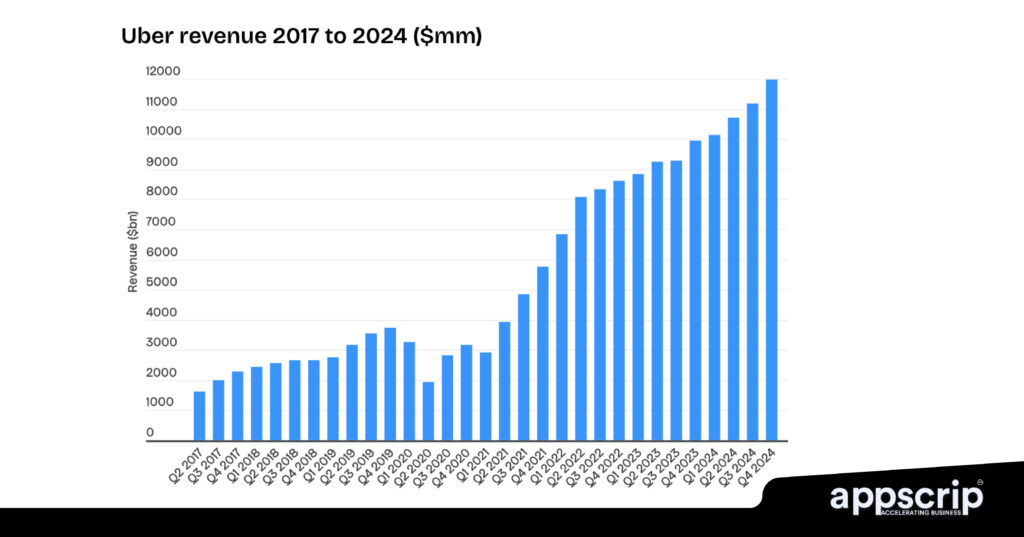
Define Core Features for Riders, Drivers & Admin
Rider App Features
Group Ride Invites: In the app, riders can directly set up and invite friends to join a ride and split costs as well. Built for planned trips, with real-time coordination and a shared ETA for all passengers.
Verified Rider Status: Drivers can build trust through rider-verified status, by knowing that rider-IDs have been checked. This is done by comparing account details to trusted sources, giving driver’s peace of mind during a ride.
Saved Places with Personalization: Frequently travelled destinations are tracked and suggested proactively. This surpasses normal ride history, making bookings faster and smarter.
Uber Reserve Enhancements: Users can schedule rides 90 days in advance with preferred drivers or vehicle types, mitigating last minute hurry. You can also reschedule rides if plans change, offering flexibility.
Driver App Features
Record My Ride Expansion: Drivers don’t really need a dashcam. They can now record trips using their smartphone’s front camera. Recordings are encrypted and saved on the device. This can be submitted for review, enhancing safety disputes.
Trip Radar Redesign: Drivers can preview and pick up multiple ride requests, with more details like distance and pay. This cuts accidental accepts with a streamlined action button.
Parking Assistance Tool: Parking in metros is a big hassle, the app now highlights the nearest free parking spots, cutting fuel wastage. The system pairs up with precise drop-off maps for efficiency.
Fare Negotiation Pilot: In certain regions, drivers and riders can agree to a fare after completing a trip. This is a shift from fixed pricing, giving drivers more control over their rides.
Admin Panel Features
Heat Map Analytics: Admins get real-time visuals of high-demand zones using geolocation data. Now they can reposition drivers, optimizing fleet availability and rider wait times.
EV Fleet Monitoring: Track electric vehicle usage, battery levels, and charging needs across the fleet. Supports Uber’s sustainability push by ensuring eco-friendly options are always available.
Predictive Maintenance Alerts: AI helps carry out preventive maintenance proactively based on mileage and trip patterns, ensuring efficiency. It cuts breakdowns, keeping drivers on the job and riders happy.
Fraud Detection Dashboard: AI-powered tools spot suspicious activity—like fake rides or payment scams in real-time. Now Admins can act fast, protecting loss of revenue and enhancing platform integrity.
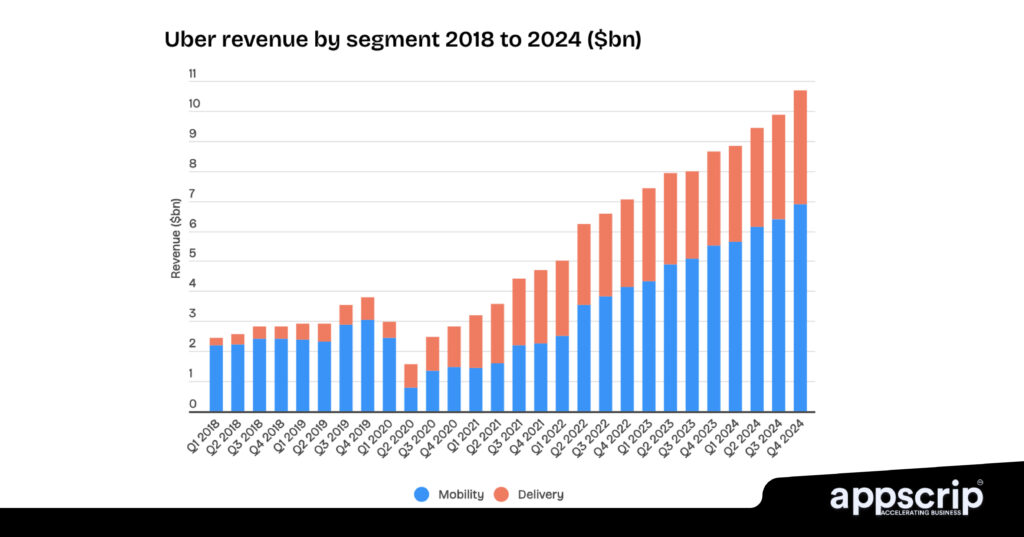
Choose the Right Tech Stack
Frontend (User Interface & Experience)
- React Native or Flutter (Cross-platform development)
- Swift (iOS) & Kotlin (Android) (For native app development)
Backend (Server & Database)
- Node.js, Python, or Java (Backend frameworks)
- MongoDB or PostgreSQL (Database for user & ride storage)
- Firebase (For real-time chat & push notifications)
APIs & Third-Party Services
- Google Maps API (for real-time tracking)
- Stripe, PayPal API (for secure payments)
- Twilio API (for SMS & notifications)
UI/UX Design & Wireframing
Before coding, create wireframes and prototypes to design a seamless user experience.
- Tools to use: Figma, Adobe XD, Sketch
- Focus areas: Minimalist design, easy navigation, fast booking process

Uber vs Lyft Food Delivery Marketshare
Development Process & Agile Approach
Build an MVP (Minimum Viable Product)
- Launch with essential features first (ride booking, payments, tracking).
- Gather user feedback to iterate & improve.
Adopt Agile Development
Work in sprints (2-4 weeks each) for rapid iteration.
Test features after each sprint instead of waiting until the end.
Testing & Quality Assurance
Before launching, perform extensive testing to eliminate bugs and glitches.
Types of Testing
- Functional Testing: Ensures all app features work as expected.
- Performance Testing: Tests how the app handles high traffic.
- Security Testing: Prevents data leaks & fraud.
- Usability Testing: Ensures smooth user experience.
Deployment & Launch
Deploy on App Stores
- Submit to Google Play Store & Apple App Store.
- Follow guidelines for app approval.
Pre-Launch Marketing
- Social Media & Influencer Marketing
- Referral & Discount Programs
- Paid Ads (Google, Facebook, Instagram)
Post-Launch Support & Scaling
After launching, continuous updates & feature enhancements are crucial.
Monitor Performance & User Feedback
- Use Google Analytics & Firebase to track user behaviour.
- Regularly update features & fix bugs.
Scale Operations
- Expand to new cities & countries.
- Introduce new ride categories (bikes, carpooling, luxury rides).

